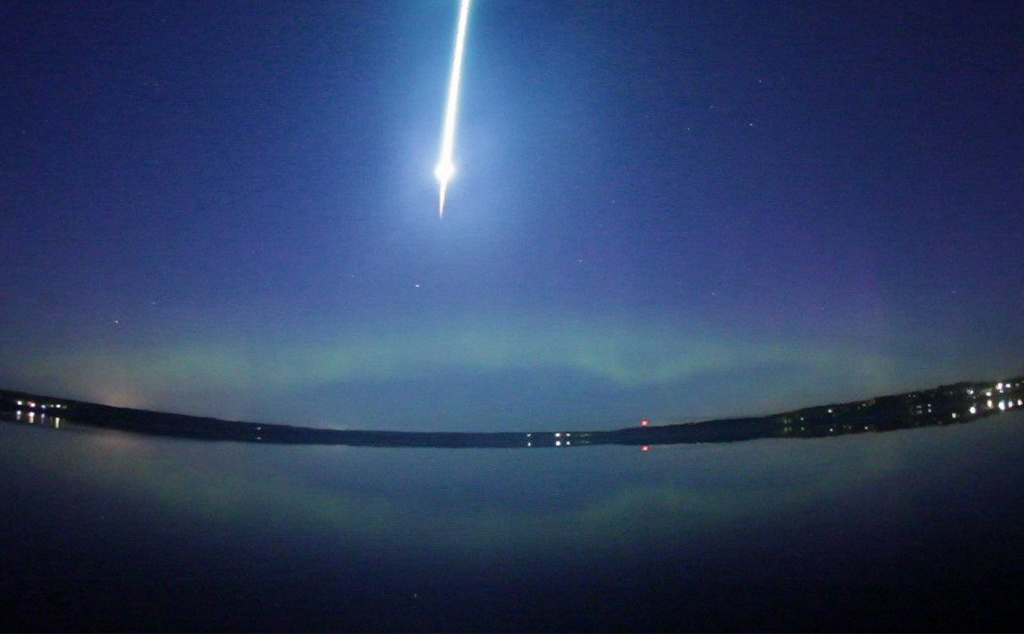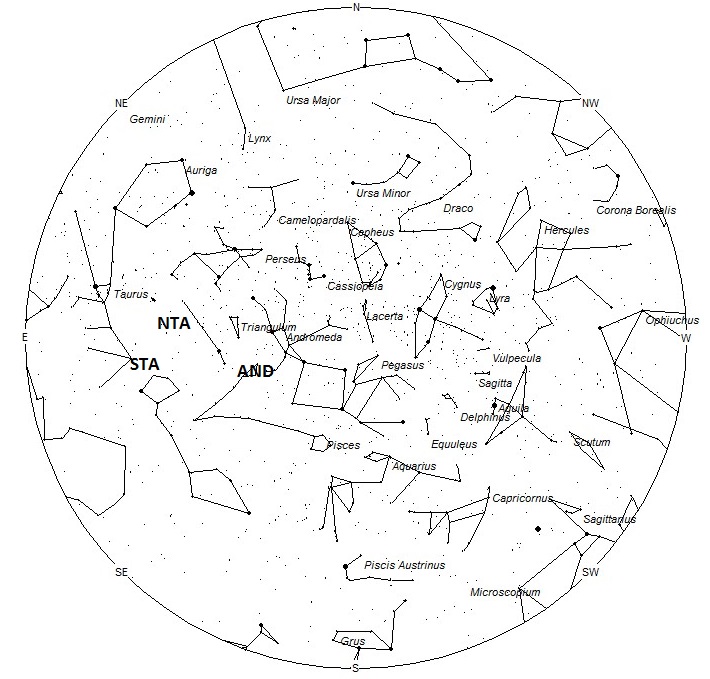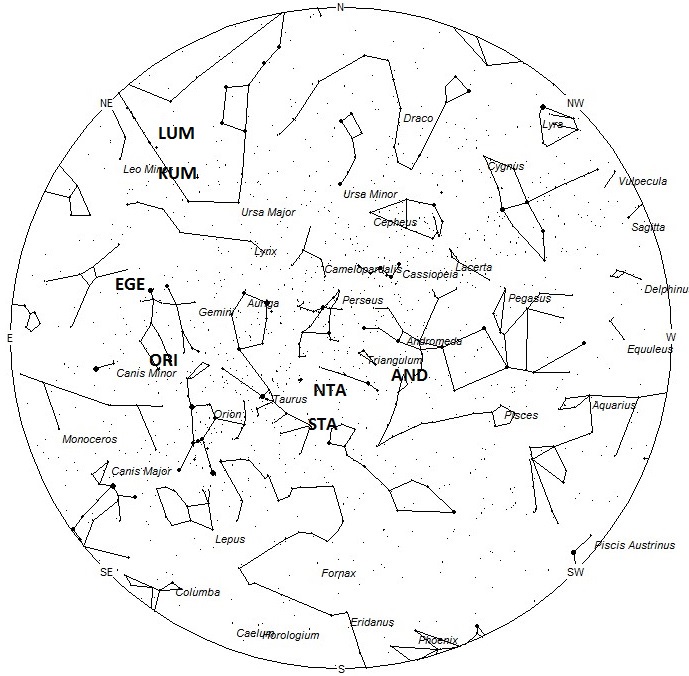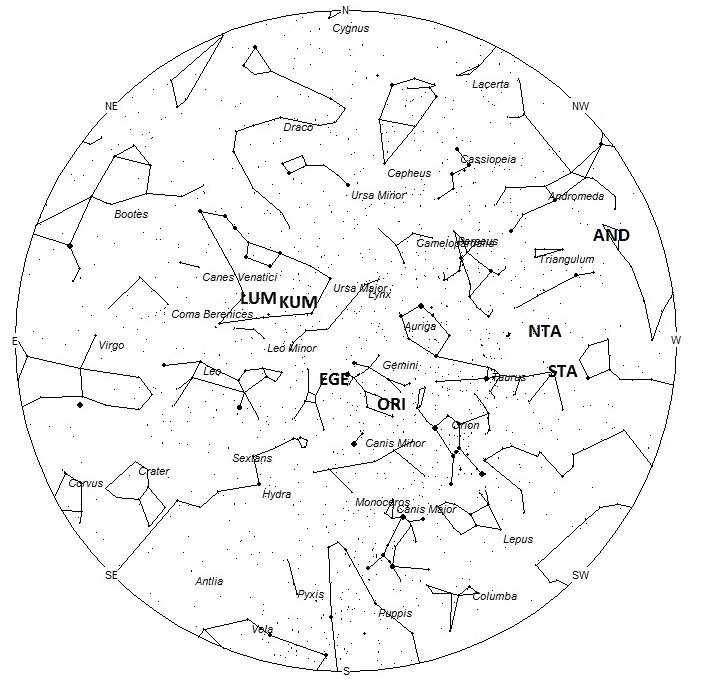
As seen from the northern hemisphere, meteor rates continue to be strong in November. While no major activity is expected this month, the two Taurid radiants plus the Leonids keep the skies active. The addition of strong sporadic rates make November one of the better months to view meteor activity from north of the equator. Skies are fairly quiet as seen from the southern hemisphere this month. Activity from the three showers mentioned above may be seen from south of the equator, but the sporadic rates are much lower than those seen in the northern hemisphere.
During this period the moon reaches it’s new phase on Sunday October 30th. At this time the moon will be located near the sun and will not be visible at night. As the week progresses the waxing crescent moon will enter the evening sky but will set long before the more active morning hours arrive. The estimated total hourly meteor rates for evening observers this week is near 6 as seen from mid-northern latitudes (45N) and 3 as seen from tropical southern locations (25S). For morning observers the estimated total hourly rates should be near 24 as seen from mid-northern latitudes (45N) and 20 as seen from tropical southern locations (25S). The actual rates will also depend on factors such as personal light and motion perception, local weather conditions, alertness and experience in watching meteor activity. Note that the hourly rates listed below are estimates as viewed from dark sky sites away from urban light sources. Observers viewing from urban areas will see less activity as only the brightest meteors will be visible from such locations.
The radiant (the area of the sky where meteors appear to shoot from) positions and rates listed below are exact for Saturday night/Sunday morning October 29/30 These positions do not change greatly day to day so the listed coordinates may be used during this entire period. Most star atlases (available at science stores and planetariums) will provide maps with grid lines of the celestial coordinates so that you may find out exactly where these positions are located in the sky. A planisphere or computer planetarium program is also useful in showing the sky at any time of night on any date of the year. Activity from each radiant is best seen when it is positioned highest in the sky, either due north or south along the meridian, depending on your latitude. It must be remembered that meteor activity is rarely seen at the radiant position. Rather they shoot outwards from the radiant so it is best to center your field of view so that the radiant lies at the edge and not the center. Viewing there will allow you to easily trace the path of each meteor back to the radiant (if it is a shower member) or in another direction if it is a sporadic. Meteor activity is not seen from radiants that are located below the horizon. The positions below are listed in a west to east manner in order of right ascension (celestial longitude). The positions listed first are located further west therefore are accessible earlier in the night while those listed further down the list rise later in the night.
These sources of meteoric activity are expected to be active this week.
.
The Andromedids (AND) will be active this week from a radiant located near 01:20 (020) +24 . This position lies in northern Pisces, 4 degrees west of the 4th magnitude star known as eta Andromedae. This part of the sky is best placed near midnight local daylight time (LDT) when the radiant lies highest above the horizon. This is a famous shower that produced some brilliant displays during the 19th century. Since then the main orbit of the particles from comet 3D/Biela have moved away from the Earth. Still, remnants may be seen from October 26 through November 20 with maximum activity occurring on November 8. Current rates would most likely be near 1 per hour as seen from the northern hemisphere and less than 1 as seen south of the equator. With an entry velocity of 19 km/sec., the average Andromedid meteor would be of very slow velocity.
The Northern Taurids (NTA) are active from a large radiant located near 03:12 (048) +21. This position lies in eastern Aries, just 1 degree north of the 4th magnitude star known as Botein (delta Arietis). Like its southern counterpart, these meteors may be seen all night long but the radiant is best placed near 0200 LDT when it lies on the meridian and is located highest in the sky. Rates at this time should be near 3 per hour as seen from the northern hemisphere and 2 as seen south of the equator. With an entry velocity of 27 km/sec., the average Northern Taurid meteor would be of slow velocity.
The Southern Taurids (STA) are also active from a large radiant centered near 03:20 (050) +13. This position lies in southeastern Aries, 3 degrees west of the 4th magnitude star known as 5 Tauri. These meteors may be seen all night long but the radiant is best placed near 0200 LDT when it lies on the meridian and is located highest in the sky. Rates at this time should be near 3 per hour regardless of your location. With an entry velocity of 29 km/sec., the average Southern Taurid meteor would be of slow velocity.
The Orionids (ORI) reached maximum activity this past week. They are still moderately active from a radiant located at 06:52 (103) +16. This area of the sky lies on the Orion/Gemini border, 3 degrees east of the 2nd magnitude star known as Alhena (gamma Geminorum). This area of the sky is best placed in the sky near 0500 LDT, when it lies highest above the horizon. Rates this weekend should be near 7 per hour no matter your location. As the week progresses, rates will gradually fall to 5 per and less. With an entry velocity of 67 km/sec., most activity from this radiant would be of swift speed.
The epsilon Geminids (EGE) are nearly over for the year. The last of these meteors can be seen from a radiant position near 08:12 (123) +28. This area of the sky lies in northwestern Cancer, 7 degrees east of the 1st magnitude star known as Pollux (beta Geminorum). This area of the sky is best placed in the sky during the last hour before dawn, when it lies highest above the horizon in a dark sky. Hourly rates should be less than 1 no matter your location. With an entry velocity of 70 km/sec., most activity from this radiant would be of swift speed.
The kappa Ursae Majorids (KUM) were discovered by cameras of the SonotaCo network in Japan during an outburst of activity on November 5, 2009. This radiant is active from November 2-9 with maximum activity occurring on the 5th. At maximum the radiant is located at 09:44 (146) +45. This position lies in southeastern Ursa Majoris, 7 degrees south of the 3rd magnitude star known as theta Ursae Majoris. Rates, even at maximum, are expected to be less than 1 regardless of your location. These meteors are best seen during the last hour before dawn when the radiant lies highest above the horizon in a dark sky. With an entry velocity of 62 km/sec., the average Kappa Ursae Majorid meteor would be of swift velocity.
The lambda Ursae Majorids (LUM) are a recent discovery by Zeljko Andreic. This weak shower is active from October 24 through November 1st with maximum activity occurring on the 27th. The radiant is currently located at 10:36 (159) +46. This position lies in a sparse area of central Ursa Major, 5 degree northeast of the 3rd magnitude star known as Tania Borealis (lambda Ursa Majoris). This area of the sky is best placed in the sky during the last hour before dawn, when it lies highest above the horizon in a dark sky. Rates should be less than 1 per hour no matter your location. With an entry velocity of 62 km/sec., most activity from this radiant would be of swift speed.
As seen from the mid-northern hemisphere (45N) one would expect to see approximately 10 sporadic meteors per hour during the last hour before dawn as seen from rural observing sites. Evening rates would be near 4 per hour. As seen from the tropical southern latitudes (25S), morning rates would be near 7 per hour as seen from rural observing sites and 3 per hour during the evening hours. Locations between these two extremes would see activity between the listed figures.
The table below presents a list of radiants that are expected to be active this week. Rates and positions are exact for Saturday night/Sunday morning except where noted in the shower descriptions.
| SHOWER | DATE OF MAXIMUM ACTIVITY | CELESTIAL POSITION | ENTRY VELOCITY | CULMINATION | HOURLY RATE | CLASS |
| RA (RA in Deg.) DEC | Km/Sec | Local Daylight Saving Time | North-South | |||
| Andromedids (AND) | Nov 08 | 01:20 (020) +24 | 19 | 22:00 | 1 – <1 | III |
| Northern Taurids (NTA) | Nov 11 | 03:12 (048) +21 | 27 | 00:00 | 3 – 2 | II |
| Southern Taurids (STA) | Oct 10 | 03:20 (050) +13 | 29 | 00:00 | 3 – 3 | II |
| Orionids (ORI) | Oct 22 | 06:52 (103) +16 | 67 | 04:00 | 7 – 7 | I |
| epsilon Geminids (EGE) | Oct 22 | 08:12 (123) +28 | 70 | 05:00 | <1 – <1 | II |
| kappa Ursa Majorids (KUM) | Nov 05 | 09:44 (146) +45 | 62 | 06:00 | <1 – <1 | IV |
| lambda Ursae Majorids (LUM) | Oct 27 | 10:36 (159) +46 | 62 | 07:00 | <1 – <1 | IV |
 American Meteor Society
American Meteor Society



We were coming home from a band performance,when my mom, myself and daughter saw an orb, green, falling from the sky, it was close, maybe 100 feet away, it came down and fell into some woods, that had houses, it came in fast, and glowed green. Never saw one that close. It hit something, do they start fires? Mom said space debris, crazy close, hope it didn’t hit a house or car. We couldn’t seem to find where it hit. Big though. We are in Newbury Ohio, is space debris common this time of year, or just random.
Laura and All,
If you look at the map of the reports of this object (http://www.amsmeteors.org/2016/11/fireball-over-pennsylvania/), you will see that it was visible over a wide area covering several states and Canada. Therefore this object had to be very high (at least 40 miles up) in the atmosphere to be seen from these distances. It is a popular illusion that these objects appear to be close by.
As for starting fires, these objects rarely make it to the ground as they usually completely disintegrate due to the forces of the atmosphere. Even if some fragments made it to the ground they would not be hot enough to ignite any fires.
I hope this helps!
Robert Lunsford